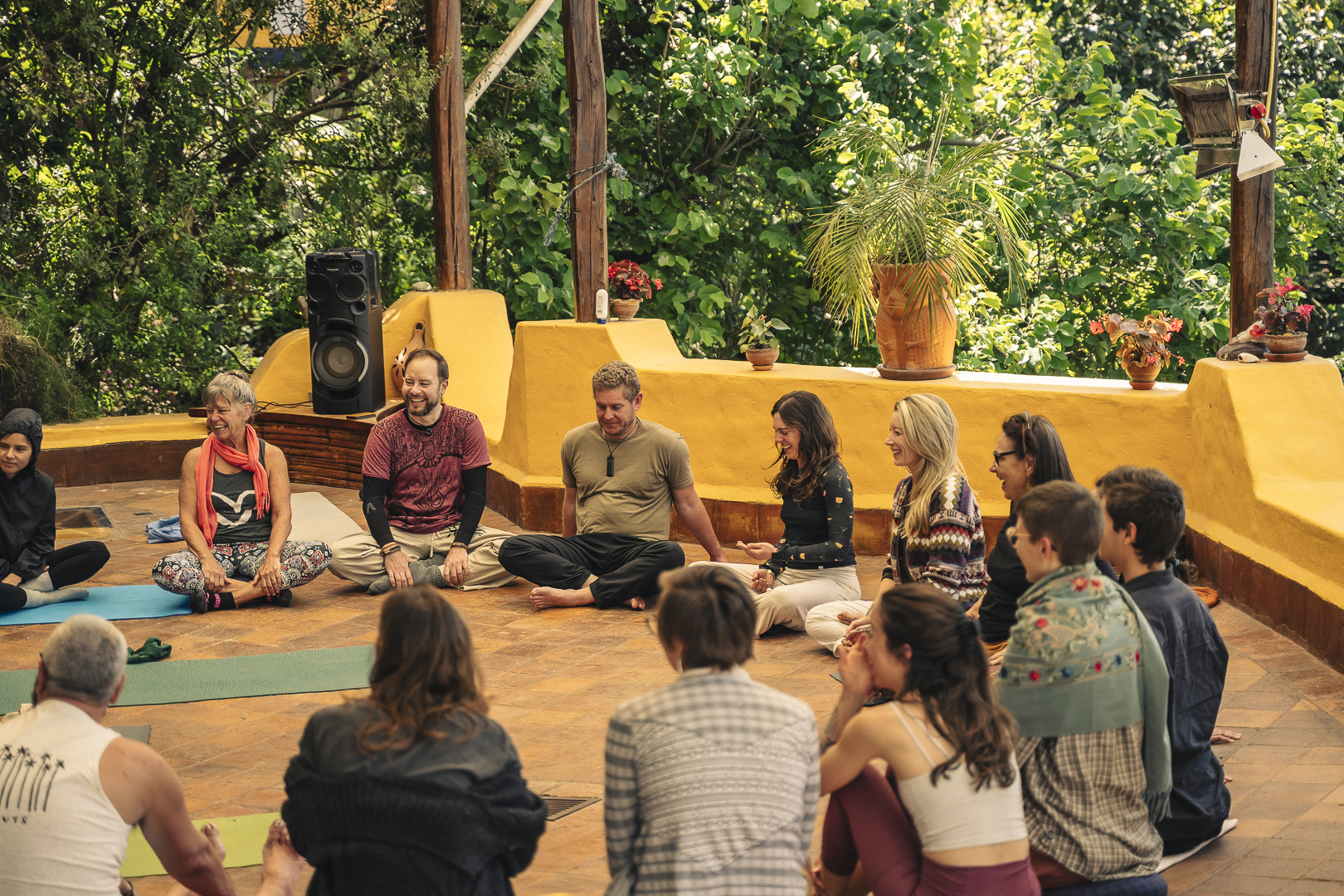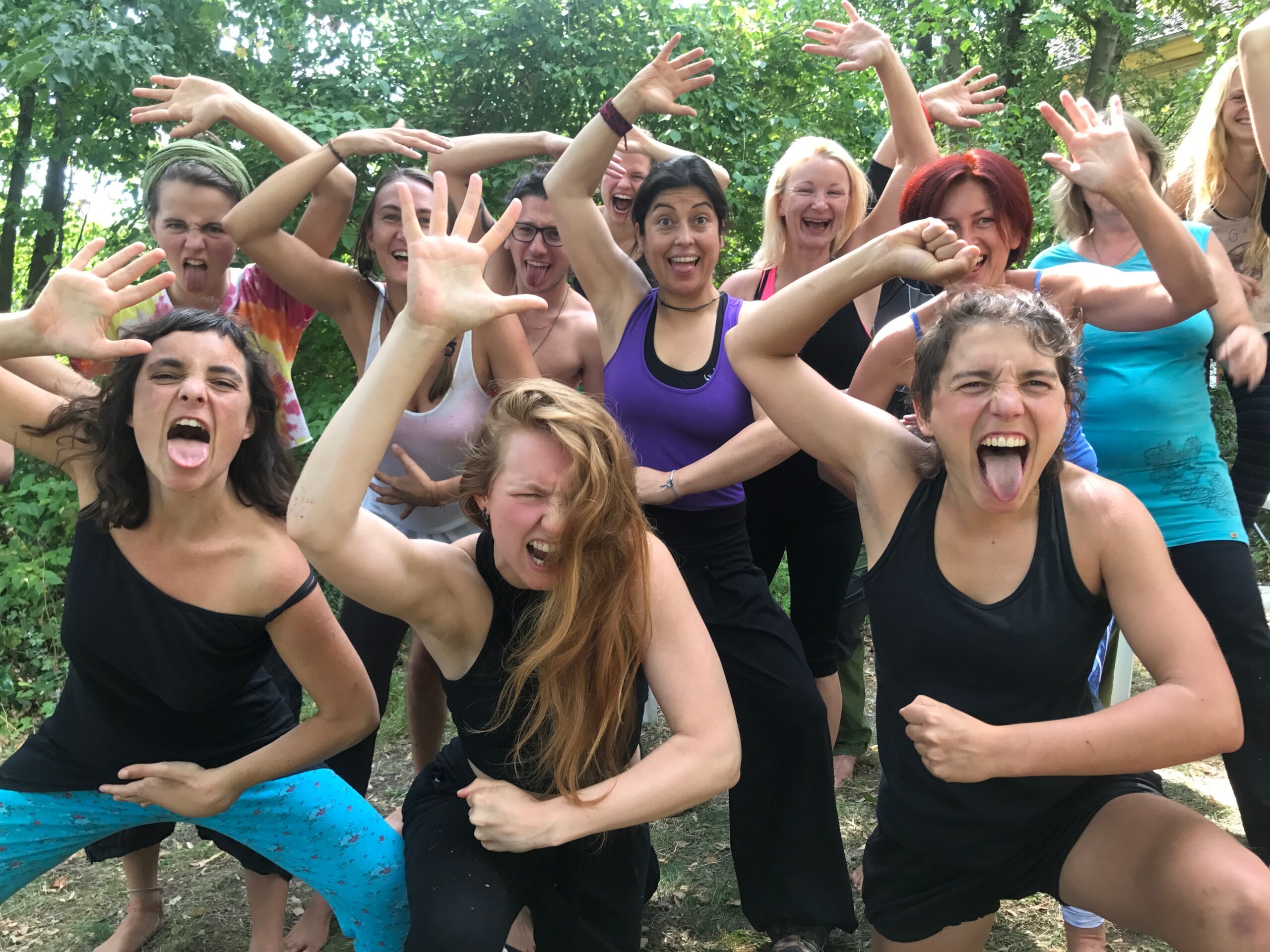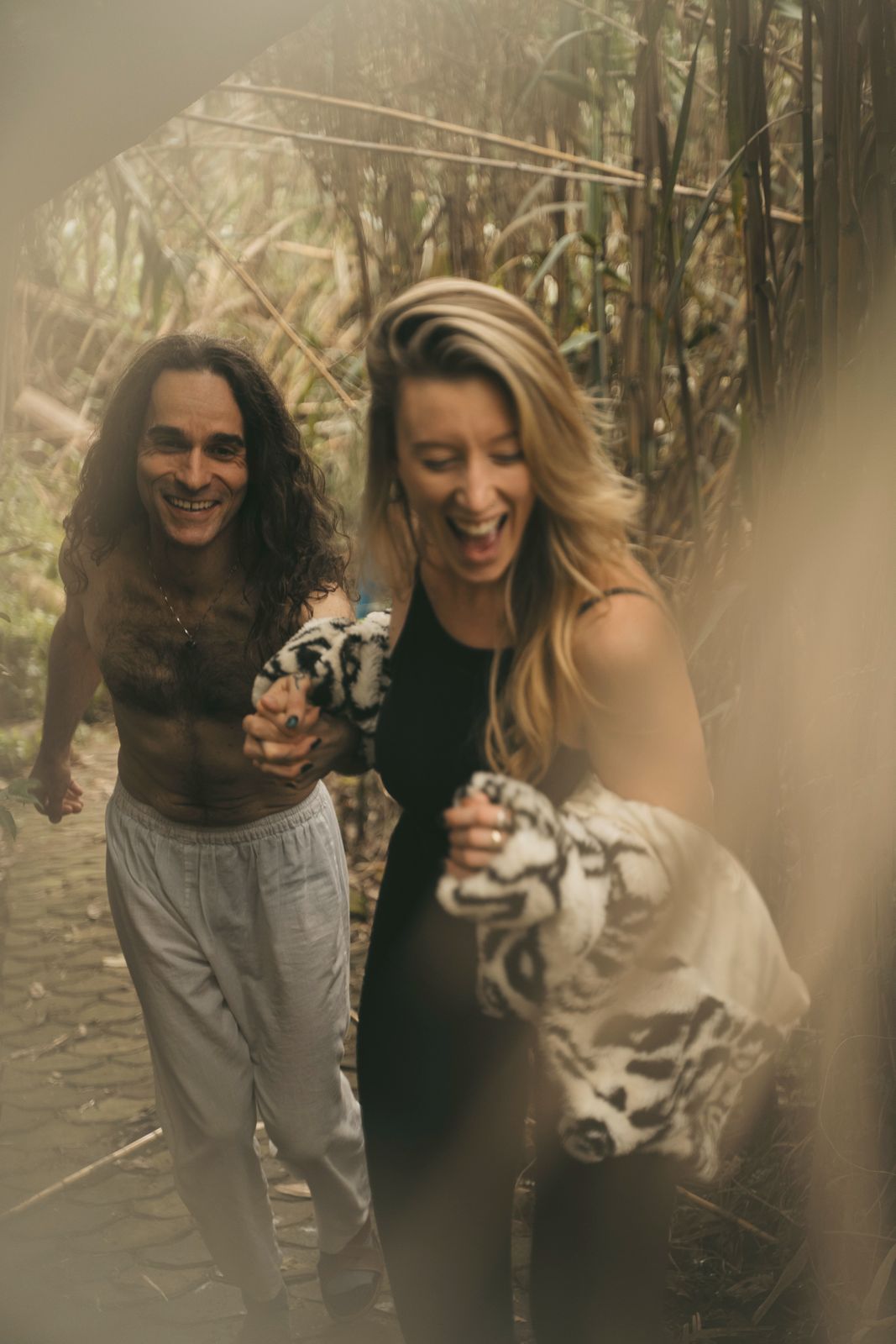In a meeting with the European team of Durga’s Tiger School ® in the community “Aloha am See” near Brandenburg. We ask ourselves, “How dangerous is asana practice to the body?” In many western yoga schools, during the yoga session we are always told, “Be careful! You could hurt yourself!”. To that end, students are given information during the practice about which muscles, tendons and organs the asana affects. And yet, there are always injuries. As we talk about it and discuss it, we feel ourselves getting tight, fear taking hold. Yoga practice becomes something that is dangerous, and we as teachers need to inform and protect our students.
We ask ourselves: why does the ancient yoga technique of Kaula Tantra Yoga reject the intervention of the teacher as an outside corrective? Why is it taboo when teaching to say, “Careful! You could hurt yourself!”?
Contents
The yoga path of trust
Kaula Tantra Yoga takes a different path. The way of trust. The way of experience. “You are not a car,” my teacher Bhagavan Shanmukha Anantha Natha used to say with a humorous smile when students would ask him to please tell them which organs or muscles an asana affects. Every asana affects the body-mind-soul unity – the fragmentation of our being, which is so important to Western thinking, has nothing to do with yoga. The same is true for alignment. Only the practitioner knows if his asana is right for him today. In Kaula Tantra Yoga practice you become your own authority. Yoga practice is not physical therapy or a competitive sport. It is a spiritual practice, and the fact that it makes the body healthy is a well-known side effect.
What does spiritual mean for us? Unlike a religious practice, it does not require belief in a given system. It is about surrendering to the mystery of being human. The techniques taught on the spiritual paths such as Buddhism, Shamanism or Yoga and Tantra support me in gaining experiential knowledge. Yes, I can experience through concrete practices that I am part of everything and everyone and yet individual. I can experience that I am tinier than a speck of dust, and yet infinite. I can experience that opposites beyond logic are not mutually exclusive – that my reality is often paradoxical. I experience that I am not my feelings and also not my thoughts? Who am I?
The body-mind-soul unity
The Kaula Tantra Yoga series is one of the oldest yoga practices still taught in India. You experience that the asanas were born from meditation, so they do not follow aesthetic principles of construction like classical ballet. My body shows them to me, manifests them as they do me good in this moment – if we allow body mind and soul to vibrate and harmonize in each asana. Our fragmenting analytical mind comes to rest during the session. The analyzing comes later. First, we trust that we can feel for ourselves how the asana unfolds within us. How does it affect our emotions? Our sense of wholeness? Our muscles, tendons, and organs? Do we trust our perception – can we really feel if we are right? Don’t we need it – the alignment from the outside, this dependence on a judgment from others: “You tell me: am I right or not?” At least since our school days, we have learned to be well-behaved and to trust others’ judgment of our performance. During deep meditation during Kaula Tantra Yoga, we learn to accept that we can be authority to ourselves, that we know if the asana for today works just right in us. We learn not to be in competition, even with ourselves.
That sounds good.
And how does that work?
Awakened Mind
During the yoga session, which lasts about three hours, we work in a deep meditative trance, riding our breath, acting out of deep relaxation. The slow deep breath maintains its pace and intensity whether I am working my muscles and being active while holding my asana, or lying relaxed on my back in Shava Asana. The yoga teacher is aware that he is talking to the subconscious of the yogis and yoginis, it is receptive to the voice of the teacher, the teacher. The body loses density, can be perceived as an energy field, connects with the intention of the practitioner.
Anna Wise, brain researcher, has found that in children during their day a play of meditative alpha, analytical betha, relaxing delta and dreaming theta waves can be measured. From school age, the brain becomes impoverished, and the analytical betha waves of waking consciousness have almost completely taken over the adult brain of the Western world. We think linearly, logically, purposefully, and think we can control reality that way. However, in moments of deep meditation, artistic impulses, brilliant ideas, inspiring Aha! Moments and ecstasy, the brain vibrates in gamma waves – a harmonic symphony in which all brain waves dance and play together. “Awakened Mind” is what she calls this state, which has been the least explored. This is exciting. Because our students tell of such peak experiences during the Kaula Tantra Yoga session and the time of their retreat. Brain research shows how the play of breath, voice and movement when using the techniques of holistic tantra and yoga path support us to creatively shape our lives with confidence and personal power, while our analytical mind alone, using mainly the beta waves, only allows us to perceive a small fragment of reality. The possibilities of human consciousness are deeper and wider. The training of Durga’s Tiger School ® is built on these facts.
Playing with the unconscious
Each time the body goes into action, the teacher’s voice sounds like a mantra: “Flow into Ada Mukha Banda Asana while you relax – flow into Sharva Asana while you relax… into Hala Asana, into Karna Pedita, into Shalaba or Danura Asana… always “while you relax”. “Play with your limits, explore them” is another announcement. “Relax your whole self”. “Invite your inner child”. “Melt into the stretch, breathe into your lower back”. And so, in relaxation, in playing with yourself and trusting, the body cannot hurt itself. It follows the teacher’s voice, the breath flows really calmly and deeply. While I’m relaxed, I can’t compete. Not even with myself. Am I not fragmented, torn into parts. I become one again – as I am meant to be. Old beliefs dissolve: “I am not right”; “I am in the world to function”; “I only have value if I achieve something”; “I have to be perfect” – yes, I experience that I am worthy of acceptance just as I am lying here today in relaxation. I allow myself this experience. This means that my “self” is allowed to relax and feel right. On this level, the asana practice of Kaula Tantra Yoga brings about healing. It becomes clear why announcements such as “be careful, you could hurt yourself” are alarm signals for the unconscious that trigger fear. The body reacts to this, tenses up. When it hears, “be gentle with yourself as you flow into the asana,” this information gives confidence at the unconscious level. During the nearly eight years that Durga’s Tiger School ® has been in existence, there have never been any injuries from the practice.
The fear of the yoga teacher
Students can “read” their teacher when they are in meditation mode and their brain waves oscillate between meditation, day consciousness, dreaming, and deep relaxation, with moments of wholeness, of ecstasy, occurring repeatedly. Their intuition is heightened, and they surrender to the here and now. They sense and their body reacts when the teacher is afraid and sees risk of injury in an asana. “I must tell them not to move their head when doing shoulder stand, otherwise…”. Therefore, it is not enough for the teacher to simply not say it – they must enter into a process of their own to build confidence in the practitioner’s body wisdom within themselves, “my students have the ability not to hurt themselves because they are relaxed.” This confidence of the teacher transfers to the students.
It is interesting for me to see that neither in India during my training period nor in Ecuador did the issue of injuries come up. If I understand our yogis correctly, they mostly occur in the Western versions of “yoga as a competitive sport.”
There is no perfect asana
To seek perfection is the death of love. Also of love for yourself. The Perfect Asana does not exist. Therefore, a good Kaula Tantra Yoga teacher will be able to guide the yogis and yoginis into a field of trust in their own ability to know. It is beautiful to witness the “Aha!” moments and wonder of our yogis and yoginis as they begin to perceive the language of the head and gut and the quiet voice of the soul.
In Sanskrit, “the knower” and “the knowing” are one. We simply need to take the inner space again to trust our heritage and apply it. Shamans call it: finding the access to the inner “lake of knowledge”. When I dive in there, the magic of my life touches me. Fear gives way. The Kaula Tantra Yoga practice is one of these ways to get there.







